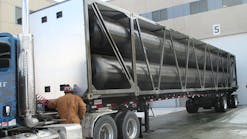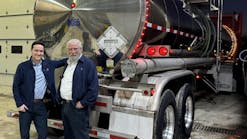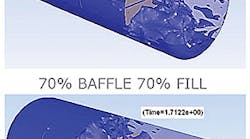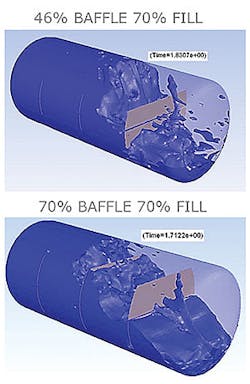The International Tank Container Organisation (ITCO) published a newly commissioned Technical Report, focusing on the anti-slosh performance of baffles in tank containers. The Report unveils the key parameters for baffle designs as means for the reduction of liquid sloshing in transport.
Liquid surge forces are quantified for a range of liquid and baffle parameters to allow for a comparative analysis against a tank without baffles. The Report shows that baffles with between 50% and 70% cross sectional surface area of the tank provide a similar reduced sloshing performance. The report was commissioned from Concave Research Center, Concordia University, Montreal PQ, Canada.
Key findings of the report are:
• Baffles provide a reduction in the transient slosh nature of the forces when compared to tanks with no baffles.
• Baffles with between 50-70% cross sectional surface areas of the tank provide similar performance.
• The effect is complex and is dependent on many factors, such as acceleration, product densities, fill levels, baffle area, etcetera.
• The effect of longitudinal sloshing during sea and rail transport is substantially lower than might potentially occur by road transport.
The Report--full title “Anti-slosh performance assessments of partial horizontal baffles with different cross-sectional surface areas”--was commissioned from Concave Research Center, Concordia University, respected international experts in this field of study and benefits from the use of the latest computerized fluid dynamics techniques. The study was carried out by Professors S Rakheja and A Kolaei, who have published a number of studies on the subject although this is the first that specifically addresses tank containers.
ITCO considers this report to be a valuable source of time variable data on longitudinal force and pitch moment which will enable the industry to further work to improve safety. As part of ITCO objectives to promote safety of tank container transport, the report was commissioned to bring a point of reference to the understanding to the subject of stability of the tank in the different transport conditions and to aid engineers in the further development of baffles in tank containers. It is proposed to develop the finding in a Work Group to be arranged at the ITCO General Meeting in October.
The complete report, giving details objectives, model development, method of analysis, results and discussion, can be downloaded by ITCO members from the ITCO website http://www.itco.org.










